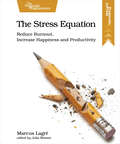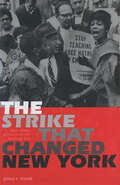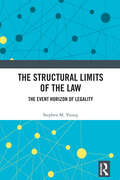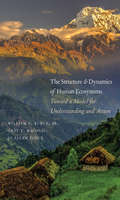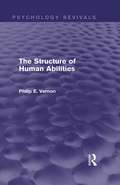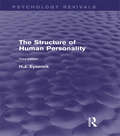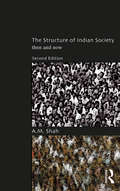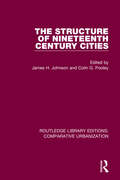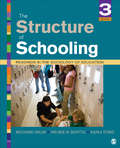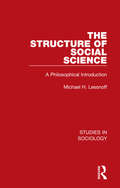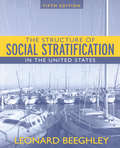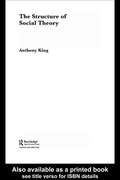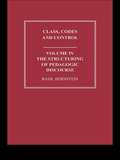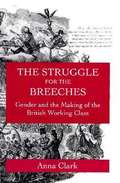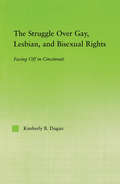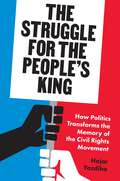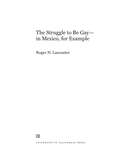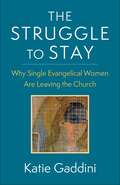- Table View
- List View
The Stress Equation
by Marcus LagreWorkplace stress is not the weakness of individuals; it's caused by systemic problems. Armed with the insights in this book, you can identify, analyze, and systematically reduce the factors that lead to poor health, low productivity, and personal burnout. This book gives you a framework for understanding stress, and a vocabulary to make it easier to discuss it among colleagues. Stress can be fixed; find out how. The interviewer asks, "How well do you cope with stress?" Your response should be, "Let's fix your environment so we don't have to." Work-related stress is one of the leading causes of mental illness among white-collar workers. It hurts companies, projects, and (most importantly) people! Stress is a burden that's created when teams stop working well. The Stress Equation is a model and a tool to help talk about stress as a systemic issue. By exploring how pressure, complexity, and security interact in software teams, we move focus away from the individual, so that we can talk about stress from a team and organizational perspective. By exploring external factors, we discuss how to solve problems rather than cope with the consequences. Whether you're an individual feeling stressed or a manager who can help, you'll learn the causes of, fixes for, and how to talk about stress. We regulate pressure by how we decide how much work we have to do and when it needs to be finished. Complexity is decided by how we handle our product and organization design. Our security is less about our pay and benefits, and more about the support and trust we feel.Stress should not be a given. Instead, it's a symptom of a diseased organization. With this book, you can begin the healing process.What You Need:No special requirements.
The Strike That Changed New York: Blacks, Whites and the Ocean Hill-Brownsville Crisis
by Jerald E. Podair&“[This] admirably balanced book will most likely stand as the definitive account of the Ocean Hill-Brownsville crisis for some time . . . engrossing.&” —New York History Winner of the Allan Nevins Prize awarded by the Society of American Historians On May 9, 1968, junior high school teacher Fred Nauman received a letter that would change the history of New York City. It informed him that he had been fired from his job. Eighteen other educators in the Ocean Hill–Brownsville area of Brooklyn received similar letters that day. The dismissed educators were white. The local school board that fired them was predominantly African-American. The crisis that the firings provoked became the most racially divisive moment in the city in more than a century, sparking three teachers&’ strikes and increasingly angry confrontations between black and white New Yorkers at bargaining tables, on picket lines, and in the streets. This superb book revisits the Ocean Hill–Brownsville crisis—a watershed in modern New York City race relations. Jerald E. Podair connects the conflict with the sociocultural history of the city and explores its legacy. The book is a powerful, sobering tale of racial misunderstanding and fear, and a New York story with national implications. &“Deftly weaves a complicated story about class and race, labor and civil rights…There are no faultless heroes or thoroughly evil villains here—only human beings struggling to make sense of their world and achieve justice as they understand it.&” —Choice &“Compelling.&” —Washington Monthly
The Strike that Changed New York: Blacks, Whites, and The Ocean Hill-brownsville Crisis
by Jerald E. PodairFred Nauman received a letter that would change the history of New York. The letter was informing him that he had been fired from his job.
The Structural Change of Knowledge and the Future of the Social Sciences
by Ronald Pohoryles Andrew SorsThis book is a compendium of pragmatism in the social sciences. While addressing several distinct spheres, it carries a common message: the future of the social sciences depends on a shared understanding of society based on the knowledge of various disciplines and transcending the currently forbidding borders between scientific knowledge and the other forms of knowledge. Looking back at the social science traditions this is nothing new. To ensure a fruitful future for the social sciences a paradigm shift is unavoidable. The consequence of the increase of knowledge in the last two centuries was the specialization of the sciences. The nineteenth century saw the separation of humanities and social sciences; the twentieth century is even characterized by specialization within the disciplines and the occurrence of competing schools of thought. This book tries to overcome the barriers that are built between and within the disciplines, and to counteract the unnecessary barriers created by the emergence of "schools of thoughts" that distrust each other and the social sciences as a whole. This book was originally published as a special issue of Innovation: The European Journal of Social Science Research.
The Structural Limits of the Law: The Event Horizon of Legality
by Stephen M. YoungThis book examines how, in response to crises, law tends to construct singular ‘events’ that obscure the underlying structural causes that any adequate response needs to acknowledge and address. Litigation is the main legal process that constructs events through a narrative that describes what happened and prescribes what should happen. Courts are theatres with competing stories and intense controversies. The legal event is compelling. But, through the examination of several cases from a range of jurisdictions, this book argues that the ability to construct and reconstruct legal events is so strong, appealing, and powerful that it limits our ability to engage in structural analysis. The difficulty of seeing beyond what is here called ‘the event horizon of legality’ interprets aspects of life as exceptional rather than structural, as it focuses attention on a limited range of possible causes, and so a limited range of possible interventions. So, if issues like famine, obesity, poverty, a rising cost of living, and climate change are even partially produced through non-eventful modalities of power, like colonialism, imperialism, or global capitalism, then, as this book analyzes, the event horizon of legality can only ensure that those issues continue. The book therefore calls for a critical re-evaluation of the role of law in shaping our representation of, and response, to crises; and so, for a rethinking of the power and promise of law. This original analysis of the operation of law will appeal to sociolegal scholars and legal theorists, as well as others working in relevant areas in critical and social theory.
The Structural Transformation Of The Public Sphere: An Inquiry Into A Category Of Bourgeois Society (Studies In Contemporary German Social Thought)
by Jurgen Habermas Thomas BurgerThis is Jurgen Habermas's most concrete historical-sociological book and one of the key contributions to political thought in the postwar period. It will be a revelation to those who have known Habermas only through his theoretical writing to find his later interests in problems of legitimation and communication foreshadowed in this lucid study of the origins, nature, and evolution of public opinion in democratic societies.
The Structure and Dynamics of Human Ecosystems: Toward a Model for Understanding and Action
by William R. Burch Gary E. Machlis Jo Ellen ForceA landmark book that strives to provide both grand theory and practical application, innovatively describing the structure and dynamics of human ecosystems As the world faces ever more complex and demanding environmental and social challenges, the need for interdisciplinary models and practical guidance becomes acute. The Human Ecosystem Model described in this landmark book provides an innovative response. Broad in scope, detailed in method, at once theoretical and applied, this grand study offers an in-depth understanding of human ecosystems and tools for action. The authors draw from Goethe’s Faust, classic anthropology and sociology studies, contemporary ecosystem ecology, Buddhist ethics, and more to create a paradigm-shifting model and a major advance in interdisciplinary ecology.
The Structure of Human Abilities (Psychology Revivals)
by Philip E. VernonFirst published in 1950, this revised edition of The Structure of Human Abilities was published in 1961, but remained largely unchanged from the original save for an additional supplement on the developments in factorial work on human abilities from 1950-1959. Much research had been carried out during the years leading up to publication, in England and America, into mental abilities; and modern methods of statistical treatment, especially factor analysis, had been increasingly used. It was felt that the mass of diverse material was apt to confuse the student of psychology of the time, especially as the results of such research were often apparently conflicting. Professor Vernon, one of the leading experts in this branch of psychology, sifted the material and attempted to provide a consistent picture of our mental structure.
The Structure of Human Personality (Psychology Revivals)
by H.J. EysenckOriginally published in 1953, this third edition was first published in 1970. It was one of the early attempts at bringing together theories of personality organisation and finding empirical evidence to test their hypotheses. This third edition includes additional chapters and updated references to current research of the time. It is a particular feature of this book that a large number of figures are reproduced in the text; this is essentially a consequence of the writer’s belief that diagrammatic representations are better suited to the transmitting and remembering of information than are words or numbers. The first chapter outlines the theories and discusses some of their implications, the second and third look at methods of analysis and projective techniques, while the rest of the book is devoted to a critical presentation of the evidence, arranged according to the technique employed – rating, self-rating, objective testing, constitutional assessment, autonomic measurement, and so on. Today it can be read and enjoyed in its historical context.
The Structure of Indian Society: Then and Now
by A. M. ShahThis book explores the structural features of Indian society, such as caste, tribe, sect, rural-urban relations, Sanskritization and untouchability. Based on a wealth of field research as well as archival material, the book Interrogates the prevailing thinking in Indian sociology on these structures; Studies Indian society from contemporary as well as historical perspectives; Analyses caste divisions vis-à-vis caste hierarchy; Critically examines the public policies regarding caste-less society, reservations for Backward Classes, and the caste census. This second edition, with four new chapters, will be a key text for students and scholars of sociology, social anthropology, political science, modern history, development studies, and South Asian studies.
The Structure of International Publishing in the 1990s
by Fred KobrakThe past decade has brought dramatic changes to the publishing industry. Publishing companies merged with one another or were bought by larger companies or media conglomerates; mergers and acquisitions crossed national boundaries and language barriers; technological advances altered the publication process and made available new media and the re-examination of the established print media. This volume examines these changes and illuminates the various prospects for the future of publishing in the coming decade.
The Structure of Nineteenth Century Cities
by Stella LowderWhen this book was first published in 1982, despite considerable research on 19th Century towns in Britain and America, there had been little attempt to search for links between these empirical studies and to relate them more to more general theories of 19th Century urban development. The book provides an integrated series of chapters which discuss trends and research problems in the study of 19th Century cities. It will be of value to researchers in urban geography, social history and historical geography.
The Structure of Schooling: Readings in the Sociology of Education
by Richard Arum Irenee R. Beattie Dr Karly S. FordThe Structure of Schooling: Readings in the Sociology of Education by Richard Arum, Irenee Beattie, and Karly Ford exposes students to examples of sociological research on schools, with a focus on the school as community. Now in its Third Edition, this engaging reader has broadened its scope even more, presenting additional readings in particular related to the sociology of higher education. The book draws from classic and contemporary scholarship to examine current issues and diverse theoretical approaches to studying the effects of schooling on individuals and society. In addition to covering traditional areas such as stratification and racial inequality, the book also veers off the beaten path, including readings on such contemporary topics as bullying, school shootings, school choice, and teen social media use.
The Structure of Social Science: A Philosophical Introduction (Studies in Sociology)
by Michael H. LessnoffOriginally published in 1974, this book provided a most useful introductory survey of all the major philosophical issues relating to the social sciences at the time. While it covers a remarkable amount of ground in a short space, it is never superficial, for its lucid and careful analysis does full justice to the complexities and controversies of the subject. Nor is it merely a survey, for, while putting all points of view with scrupulous fairness, the author never fails to make clear his own, and to support it with reasoned argument. The book’s basic framework is a comparison of physical and social science, and in this context the author examines the problems of the mental aspect of social life, general laws, the individual and the social, explanation, and the relation of fact to value. He is far from advocating (as is often done) the wholesale acceptance or rejection of the ‘physical science model’ in the social sciences – rather, he carefully considers the various elements of the model in relation to the nature of social life. A noteworthy feature of this book is the philosophical analysis of statistical correlations and tests of significance, which bulk so large in the practice of social scientists, yet are all too seldom discussed in books of this kind. Also of special interest is the penetrating and original analysis of functionalist explanation in social science. Students of the social sciences and of philosophy will find this an admirable introduction to an important aspect of their respective disciplines.
The Structure of Social Stratification in the United States, The, CourseSmart eTextbook
by Leonard BeeghleyThis book distills out of the rich vein of sociological research some of what is known about the structure of stratification in the United States. It emphasizes the importance of power for understanding the structure of stratification.
The Structure of Social Theory (Routledge Studies in Social and Political Thought #Vol. 39)
by Anthony KingDrawing on the work of Gadamer, the book demonstrates that a sociology which focuses on social relations does not imply a return to idealism, nor a retreat into individualism, nor a rejection of critique. Rather, a hermeneutic sociology which prioritises human social relations is the only coherent paradigm which is available today. The author argues that sociologists studying the dramatic social transformations which are currently occuring should focus on social relations between humans; they should not attempt to understand contemporary changes in terms of structure and agency.
The Structure of a Moral Code: Navajo Ethics
by John LaddIn this book, the author presents a philosophical analysis of the nature and structure of a moral code. Mr. Ladd shows how the codes of other societies can be described with scientific rigor and objectivity. He develops a general theory of moral codes which holds considerable significance for moral philosophers and which presents for anthropologists a methodology for their investigations into the ethical systems of non-literate cultures.
The Structuring of Pedagogic Discourse
by Basil BernsteinThis book represents part of an ongoing effort to understand the rules, practices, agencies and agents which shape and change the social construction of pedagogic discourse. It draws together and re-examines the findings of the author's earlier work.
The Struggle For Community
by Allan David HeskinDrawing on a case study of multi-ethnic working-class tenants in Los Angeles, this book describes the group's successful fight against displacement. It examines how community leaders establish their hegemony and addresses the roles of class, ethnicity and gender in community struggles.
The Struggle For The Breeches: Gender And The Making Of The British Working Class (Studies On The History Of Society And Culture #23)
by Anna ClarkLinking the personal and the political, Anna Clark depicts the making of the working class in Britain as a "struggle for the breeches." The late eighteenth and early nineteenth centuries witnessed significant changes in notions of masculinity and femininity, the sexual division of labor, and sexual mores, changes that were intimately intertwined with class politics. By integrating gender into the analysis of class formation, Clark transforms the traditional narrative of working-class history. Going beyond the sterile debate about whether economics or language determines class consciousness, Clark integrates working people's experience with an analysis of radical rhetoric. Focusing on Lancashire, Glasgow, and London, she contrasts the experience of artisans and textile workers, demonstrating how each created distinctively gendered communities and political strategies. Workers faced a "sexual crisis," Clark claims, as men and women competed for jobs and struggled over love and power in the family. While some radicals espoused respectability, others might be homophobes, wife-beaters, and tyrants at home; a radical's love of liberty could be coupled with lust for the life of a libertine. Clark shows that in trying to create a working class these radicals closed off the movement to women, instead adopting a conservative rhetoric of domesticity and narrowing their notion of the working class. Linking the personal and the political, Anna Clark depicts the making of the working class in Britain as a "struggle for the breeches." The late eighteenth and early nineteenth centuries witnessed significant changes in notions of masculinity and femininity, the sexual division of labor, and sexual mores, changes that were intimately intertwined with class politics. By integrating gender into the analysis of class formation, Clark transforms the traditional narrative of working-class history. Going beyond the sterile debate about whether economics or language determines class consciousness, Clark integrates working people's experience with an analysis of radical rhetoric. Focusing on Lancashire, Glasgow, and London, she contrasts the experience of artisans and textile workers, demonstrating how each created distinctively gendered communities and political strategies. Workers faced a "sexual crisis," Clark claims, as men and women competed for jobs and struggled over love and power in the family. While some radicals espoused respectability, others might be homophobes, wife-beaters, and tyrants at home; a radical's love of liberty could be coupled with lust for the life of a libertine. Clark shows that in trying to create a working class these radicals closed off the movement to women, instead adopting a conservative rhetoric of domesticity and narrowing their notion of the working class.
The Struggle Over Gay, Lesbian, and Bisexual Rights: Facing off in Cincinnati
by Kimberly B. DuganIn November 1993 voters in Cincinnati, Ohio passed Issue 3, an amendment to the City Charter eliminating gay, lesbian, and bisexual persons' legal protection against discrimination and prohibiting their recognition as a group or class. This Christian right initiative emerged largely in response to the inclusion of "sexual orientation" in the city's newly enacted Human Rights Ordinance just one year earlier. Using qualitative data, Kimberly Dugan captures the dynamics and interdependence of the gay, lesbian, and bisexual movement and the Christian right as they engaged in conflict over Issue 3 by focusing on cultural factors relevant to movement mobilization, strategies, and success.
The Struggle for the People’s King: How Politics Transforms the Memory of the Civil Rights Movement
by Hajar YazdihaHow the misuses of Martin Luther King’s legacy divide us and undermine democracyIn the post–civil rights era, wide-ranging groups have made civil rights claims that echo those made by Black civil rights activists of the 1960s, from people with disabilities to women’s rights activists and LGBTQ coalitions. Increasingly since the 1980s, white, right-wing social movements, from family values coalitions to the alt-right, now claim the collective memory of civil rights to portray themselves as the newly oppressed minorities. The Struggle for the People’s King reveals how, as these powerful groups remake collective memory toward competing political ends, they generate offshoots of remembrance that distort history and threaten the very foundations of multicultural democracy.In the revisionist memories of white conservatives, gun rights activists are the new Rosa Parks, antiabortion activists are freedom riders, and antigay groups are the defenders of Martin Luther King’s Christian vision. Drawing on a wealth of evidence ranging from newspaper articles and organizational documents to television transcripts, press releases, and focus groups, Hajar Yazdiha documents the consequential reimagining of the civil rights movement in American political culture from 1980 to today. She shows how the public memory of King and civil rights has transformed into a vacated, sanitized collective memory that evades social reality and perpetuates racial inequality.Powerful and persuasive, The Struggle for the People’s King demonstrates that these oppositional uses of memory fracture our collective understanding of who we are, how we got here, and where we go next.
The Struggle of Latino/Latina University Students: In Search of a Liberating Education
by Felix M. PadillaBased on a three-year ethnographic study of a class on the sociology of Latino/a society, this book tells the story of how the students navigated academic life in a predominantly white university to construct their own education. Padilla weaves together journal entries, his own experiences in education, cultural analysis, and theory to create a ric
The Struggle to Be Gay—in Mexico, for Example
by Roger N. LancasterBeing gay is not a given. Through a rigorous ethnographic inquiry into the material foundations of sexual identity, The Struggle to Be Gay makes a compelling argument for the centrality of social class in gay life—in Mexico, for example, and by extension in other places as well. Known for his writings on the construction of sexual identities, anthropologist and cultural studies scholar Roger N. Lancaster ponders four decades of visits to Mexican cities. In a brisk series of reflections combining storytelling, ethnography, critique, and razor-edged polemic, he shows, first, how economic inequality affects sexual subjects and subjectivities in ways both obvious and subtle, and, second, how what it means to be de ambiente—"on the scene" or "in the life"—has metamorphosed under changing political-economic conditions. The result is a groundbreaking intervention into ongoing debates over identity politics—and a renewal of our understanding of how identities are constructed, struggled for, and lived.
The Struggle to Stay: Why Single Evangelical Women Are Leaving the Church
by Katie GaddiniEvangelical Christianity is often thought of as oppressive to women. The #MeToo era, when many women hit a breaking point with rampant sexism, has also reached evangelical communities. Yet more than thirty million women in the United States still identify as evangelical. Why do so many women remain in male-dominated churches that marginalize them, and why do others leave? In each case, what does this cost them?The Struggle to Stay is an intimate and insightful portrait of single women’s experiences in evangelical churches. Drawing on unprecedented access to churches in the United States and the United Kingdom, Katie Gaddini relates the struggles of four women, interwoven with her own story of leaving behind a devout faith. She connects these personal narratives with rigorous analysis of Christianity and politics in both countries, and contextualizes them through interviews with more than fifty other evangelical women. Gaddini grapples with the complexities of obedience and resistance for women within a patriarchal religion against the backdrop of a culture war. Her exploration of how women choose to leave or remain in environments that constrain them is nuanced and personal, telling powerful stories of faith, community, isolation, and loss. Bringing together meticulous research and deep empathy, The Struggle to Stay provides a revelatory account of the private burdens that evangelical women bear.
